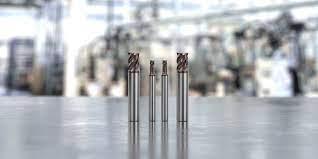
To address the challenges of difficult and unstable machining conditions caused by long tool overhangs, the Seco JS754 Stub Series end mills feature short protrusion lengths that maximize tooling value while increasing tool life by 20 to 40%.
The four-flute end mill is designed for mill-turn and multi-tasking machines and incorporates the industry- proven JS754 cutting geometry and unique HXT coating for high performance machining. This design makes the Seco JS754 series ideal for difficult applications involving ISO M (stainless steel) and S (heat-resistant superalloys and titanium) materials. The shorter length of the JS754 Stub adds strength and vibration control for increased tool stability when machining with main or sub spindles, as well as with milling heads and driven tools.
Ideal for minimum clearance setups
Many CNC mill-turn and multi-tasking machines are designed with a limited machining envelope that can prohibit the use of longer end mills. The JS754 Stub Series’ short protrusion lengths require less room in the sub- or 2nd spindles of these machines. This end mill series provides freedom of movement to easily maneuver around workpieces with increased tool stability in these tight workspaces, which allows shops to maximize the benefits that mill-turn and multi-tasking machines offer, including shorter setup times and improved part quality.
The JS754 Stub series is offered in both chamfer and corner radius configurations in diameters from 3 mm to 16 mm and is available in cylindrical and Weldon shanks.
“Within all manufacturing segments, especially general machining and aerospace, the high-mix/low volume (HMLV) production environment continues to drive the need for automation and efficiency, achieved most commonly through mill-turn and multi-tasking machines,” said Rob Mulders of SECO Tools. ”The JS754 Stub Series contributes significant flexiblility for the single-setup part manufacturing, which these multi-purpose machines provide.”
Reduced end mill waste
Due to its shorter cutting length, the JS754 Stub end mills provide full cutter engagement along the entire length of the tool. This maximizes cutter edge use, which helps reduce carbide waste for improved efficiency and increased sustainability.
Contact Details
Related Glossary Terms
- clearance
clearance
Space provided behind a tool’s land or relief to prevent rubbing and subsequent premature deterioration of the tool. See land; relief.
- computer numerical control ( CNC)
computer numerical control ( CNC)
Microprocessor-based controller dedicated to a machine tool that permits the creation or modification of parts. Programmed numerical control activates the machine’s servos and spindle drives and controls the various machining operations. See DNC, direct numerical control; NC, numerical control.
- gang cutting ( milling)
gang cutting ( milling)
Machining with several cutters mounted on a single arbor, generally for simultaneous cutting.
- milling
milling
Machining operation in which metal or other material is removed by applying power to a rotating cutter. In vertical milling, the cutting tool is mounted vertically on the spindle. In horizontal milling, the cutting tool is mounted horizontally, either directly on the spindle or on an arbor. Horizontal milling is further broken down into conventional milling, where the cutter rotates opposite the direction of feed, or “up” into the workpiece; and climb milling, where the cutter rotates in the direction of feed, or “down” into the workpiece. Milling operations include plane or surface milling, endmilling, facemilling, angle milling, form milling and profiling.
- milling machine ( mill)
milling machine ( mill)
Runs endmills and arbor-mounted milling cutters. Features include a head with a spindle that drives the cutters; a column, knee and table that provide motion in the three Cartesian axes; and a base that supports the components and houses the cutting-fluid pump and reservoir. The work is mounted on the table and fed into the rotating cutter or endmill to accomplish the milling steps; vertical milling machines also feed endmills into the work by means of a spindle-mounted quill. Models range from small manual machines to big bed-type and duplex mills. All take one of three basic forms: vertical, horizontal or convertible horizontal/vertical. Vertical machines may be knee-type (the table is mounted on a knee that can be elevated) or bed-type (the table is securely supported and only moves horizontally). In general, horizontal machines are bigger and more powerful, while vertical machines are lighter but more versatile and easier to set up and operate.
- superalloys
superalloys
Tough, difficult-to-machine alloys; includes Hastelloy, Inconel and Monel. Many are nickel-base metals.

